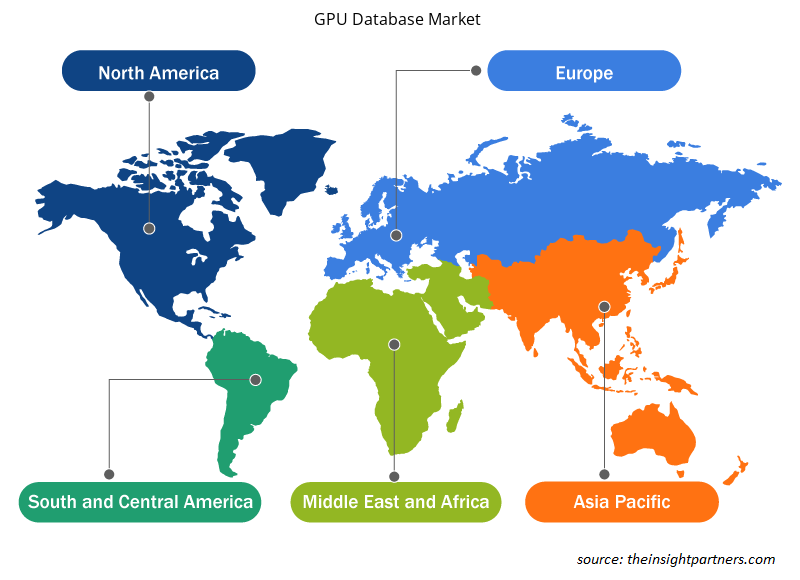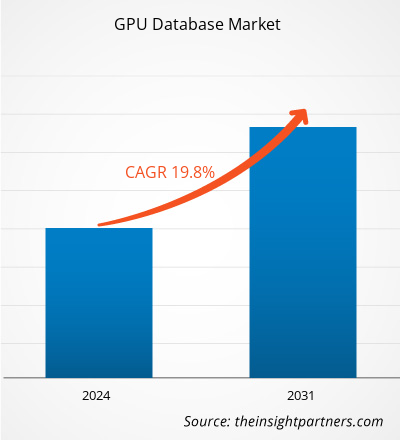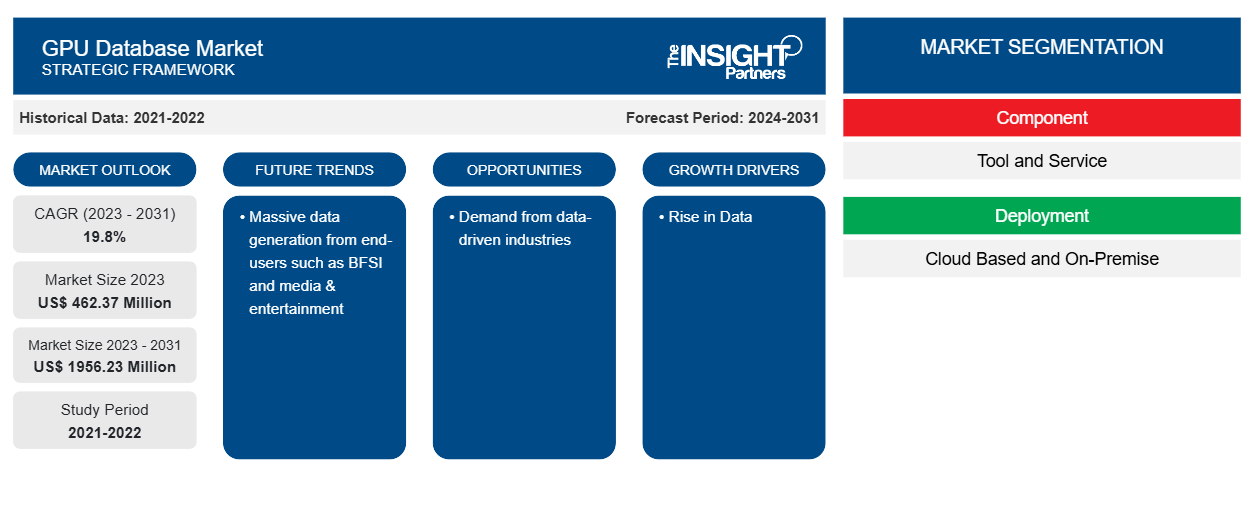Si prevede che la dimensione del mercato dei database GPU raggiungerà 1956,23 milioni di dollari entro il 2031, rispetto ai 462,37 milioni di dollari del 2023. Si prevede che il mercato registrerà un CAGR del 19,8% nel periodo 2023-2031. L'aumento dei dati e la crescita delle industrie basate sui dati rimarranno probabilmente tendenze chiave nel mercato.
Analisi di mercato del database GPU
Le crescenti industrie basate sui dati sono uno dei principali fattori trainanti del mercato dei database GPU. L'aumento della digitalizzazione e l'inclinazione delle aziende verso soluzioni per elaborare grandi set di dati stanno alimentando la crescita del mercato. Il database GPU trova la sua applicazione in alcune delle tecnologie emergenti come l'intelligenza artificiale, l'apprendimento automatico e profondo, l'Internet of Things (IoT) e l'analisi geospaziale, che crea enormi opportunità per la crescita del mercato dei database GPU.
Panoramica del mercato dei database GPU
Un database GPU utilizza unità di elaborazione grafica (GPU) per eseguire operazioni di database. Una GPU è un processore programmabile progettato per eseguire rapidamente il rendering di immagini e video ad alta risoluzione. Il database GPU elabora enormi volumi di dati in modo più rapido ed efficace rispetto alle CPU perché operano in parallelo anziché in sequenza. Pertanto, i database GPU sono in genere più veloci e orientati all'analisi, che è più flessibile nell'elaborazione di molti tipi diversi di dati o di quantità di dati molto più grandi.
Personalizza questo report in base alle tue esigenze
Riceverai la personalizzazione gratuita di qualsiasi report, comprese parti di questo report, o analisi a livello nazionale, pacchetto dati Excel, oltre a usufruire di grandi offerte e sconti per start-up e università
-
Scopri le principali tendenze di mercato in questo rapporto.Questo campione GRATUITO includerà analisi di dati che spaziano dalle tendenze di mercato alle stime e alle previsioni.
Driver e opportunità del mercato dei database GPU
Aumento dei dati a favore del mercato
Con l'avvento della digitalizzazione, i dati vengono generati a una velocità incredibile. I dati di varie varietà, volumi e velocità devono essere analizzati ed elaborati per realizzare qualsiasi schema nascosto e approfondimento con l'aiuto di tecniche di analisi dei dati . L'analisi tradizionale non riesce a fornire tecniche e tecnologie di analisi ottimali. Ciò genera la necessità di un database GPU. Con capacità di elaborazione parallela massiva, il database GPU fornisce in modo conveniente un'elaborazione ad alte prestazioni. Il database GPU è una soluzione ideale per gestire grandi set di dati, il che determina la domanda di questa tecnologia.
Domanda da parte dei settori basati sui dati.
I dati GPU hanno un'elevata potenza di calcolo. Grazie alle loro capacità di elaborazione parallela, possono elaborare dati fino a 100 volte più velocemente rispetto alle configurazioni contenenti solo CPU, come illustrato. Pertanto, vari settori basati sui dati come BFSI, media e intrattenimento e altri richiedono soluzioni per carichi di lavoro ad alta intensità di elaborazione per applicazioni di analisi dei dati, il che determina la domanda di database GPU. Gli operatori di mercato stanno lanciando soluzioni per soddisfare questa domanda. Graphistry ha lanciato Hub Pro (Graphistry Hub for Professionals) per offrire ai clienti l'analisi grafica visiva accelerata da GPU. Graphistry Hub Pro risolve i problemi di sicurezza, prezzi e manutenzione per gli individui e le prossime Hub Organizations per i team. (Fonte: Graphistry, comunicato stampa, settembre 2021)CPUs, as illustrated. Thus, various data-driven industries such as BFSI, media & entertainment, and others demand solutions to processing-intensive workloads for data analytics applications, which drives the demand for GPU databases. The market players are launching solutions to cater to this demand. Graphistry launched Hub Pro (Graphistry Hub for Professionals) to bring GPU-accelerated visual graph analysis to customers. Graphistry Hub Pro solves security, pricing, and maintenance for individuals, and the upcoming Hub Organizations for teams. (Source: Graphistry, Press Release, September 2021)
Analisi della segmentazione del rapporto di mercato del database GPU
I segmenti chiave che hanno contribuito alla derivazione dell'analisi di mercato del database GPU sono componenti, distribuzione, applicazione e settore verticale.
- In base al componente, il mercato dei database GPU è diviso in strumenti e servizi. Il segmento degli strumenti ha detenuto la quota maggiore del mercato nel 2023.
- Per distribuzione, il mercato è segmentato in cloud based e on-premise. Si prevede che il cloud based crescerà con il CAGR più elevato.CAGR.
- Per applicazione, il mercato è segmentato in rilevamento e prevenzione delle frodi, governance risk & compliance (GRC), gestione dell'esperienza del cliente, manutenzione predittiva, gestione della supply chain, threat intelligence e altri. La gestione dell'esperienza del cliente ha detenuto una quota significativa del mercato nel 2023.GRC), customer experience management, predictive maintenance, supply chain management, threat intelligence, and others. The customer experience management held a significant share of the market in 2023.
- Per settore verticale, il mercato è segmentato in BFSI, IT e telecomunicazioni, vendita al dettaglio ed e-commerce, sanità, trasporti e logistica, governo e difesa e altri. Il BFSI ha detenuto una quota significativa del mercato nel 2023.BFSI, IT & telecom, retail & e-commerce, healthcare, transportation & logistics, government & defense, and others. The BFSI held a significant share of the market in 2023.
Analisi della quota di mercato del database GPU per area geografica
L'ambito geografico del rapporto di mercato sui database GPU è suddiviso principalmente in cinque regioni: Nord America, Asia Pacifico, Europa, Medio Oriente e Africa, Sud e Centro America.
Si prevede che la regione Asia-Pacifico crescerà con il CAGR più elevato. L'aumento della digitalizzazione e la crescente domanda di tecniche avanzate di analisi dei dati nelle economie in via di sviluppo come India e Cina stanno guidando la crescita del mercato nella regione. La trasformazione digitale in settori basati sui dati come BFSI, sanità, produzione e altri, guida ulteriormente la crescita del mercato. La crescente domanda di estrazione di informazioni da grandi set di dati sta alimentando la crescita del mercato in Asia-Pacifico.CAGR. The rise in digitalization and growing demand for advanced data analytics techniques in developing economies such as India and China is driving market growth in the region. Digital transformation across data-driven industries such as BFSI, healthcare, manufacturing, and others, further drives market growth. The increasing demand for extracting insights from large datasets is fuelling the market growth in Asia Pacific.
Approfondimenti regionali sul mercato dei database GPU
Le tendenze regionali e i fattori che influenzano il mercato dei database GPU durante il periodo di previsione sono stati ampiamente spiegati dagli analisti di Insight Partners. Questa sezione discute anche i segmenti e la geografia del mercato dei database GPU in Nord America, Europa, Asia Pacifico, Medio Oriente e Africa e America meridionale e centrale.

- Ottieni i dati specifici regionali per il mercato dei database GPU
Ambito del rapporto di mercato del database GPU
| Attributo del report | Dettagli |
|---|---|
| Dimensioni del mercato nel 2023 | 462,37 milioni di dollari USA |
| Dimensioni del mercato entro il 2031 | 1956,23 milioni di dollari USA |
| CAGR globale (2023-2031) | 19,8% |
| Dati storici | 2021-2022 |
| Periodo di previsione | 2024-2031 |
| Segmenti coperti |
Per componente
|
| Regioni e Paesi coperti |
America del Nord
|
| Leader di mercato e profili aziendali chiave |
|
Densità dei giocatori del mercato del database GPU: comprendere il suo impatto sulle dinamiche aziendali
Il mercato del database GPU sta crescendo rapidamente, spinto dalla crescente domanda degli utenti finali dovuta a fattori quali l'evoluzione delle preferenze dei consumatori, i progressi tecnologici e una maggiore consapevolezza dei vantaggi del prodotto. Con l'aumento della domanda, le aziende stanno ampliando le loro offerte, innovando per soddisfare le esigenze dei consumatori e capitalizzando sulle tendenze emergenti, il che alimenta ulteriormente la crescita del mercato.
La densità degli operatori di mercato si riferisce alla distribuzione di aziende o società che operano in un particolare mercato o settore. Indica quanti concorrenti (operatori di mercato) sono presenti in un dato spazio di mercato in relazione alle sue dimensioni o al valore di mercato totale.
Le principali aziende che operano nel mercato dei database GPU sono:
- BRYTLYT
- GRAFISTERIA
- H2O.ai
- Giusto
- Kinetica DB Inc.
- Neo4J, INC.
Disclaimer : le aziende elencate sopra non sono classificate secondo un ordine particolare.

- Ottieni la panoramica dei principali attori del mercato del database GPU
Notizie di mercato e sviluppi recenti del database GPU
Il mercato dei database GPU viene valutato raccogliendo dati qualitativi e quantitativi dopo la ricerca primaria e secondaria, che include importanti pubblicazioni aziendali, dati associativi e database. Di seguito sono elencati alcuni degli sviluppi nel mercato dei database GPU:
- NVIDIA e HP Inc. hanno annunciato l'integrazione delle librerie di elaborazione dati NVIDIA CUDA-X con le soluzioni workstation HP AI per potenziare il lavoro di preparazione ed elaborazione dati che costituisce la base dello sviluppo di AI generativa. Basate sulla piattaforma di elaborazione NVIDIA CUDA, le librerie CUDA-X velocizzano l'elaborazione dati per un'ampia gamma di tipi di dati, tra cui tabelle, testo, immagini e video. Includono la libreria NVIDIA RAPIDS cuDF, che accelera il lavoro di quasi 10 milioni di data scientist che utilizzano il software pandas fino a 110 volte utilizzando una GPU NVIDIA RTX 6000 Ada Generation anziché un sistema solo CPU, senza richiedere alcuna modifica al codice. (Fonte: NVIDIA, comunicato stampa, marzo 2024)
- Zilliz, pioniere nella tecnologia dei database vettoriali , ha annunciato il rilascio di Milvus 2.4, stabilendo un nuovo standard nelle capacità di ricerca vettoriale con una rivoluzionaria funzionalità di indicizzazione GPU basata su CUDA-Accelerated Graph Index for Vector Retrieval (CAGRA) di NVIDIA, parte della libreria RAPIDS cuVS. (Fonte: Zilliz, comunicato stampa, marzo 2024)
Copertura e risultati del rapporto sul mercato dei database GPU
Il rapporto "Dimensioni e previsioni del mercato del database GPU (2021-2031)" fornisce un'analisi dettagliata del mercato che copre le seguenti aree:
- Dimensioni e previsioni del mercato dei database GPU a livello globale, regionale e nazionale per tutti i segmenti di mercato chiave coperti dall'ambito
- Tendenze del mercato del database GPU e dinamiche di mercato come driver, vincoli e opportunità chiave
- Analisi dettagliata delle cinque forze PEST/Porter e SWOT
- Analisi di mercato del database GPU che copre le principali tendenze del mercato, il quadro globale e regionale, i principali attori, le normative e i recenti sviluppi del mercato
- Analisi del panorama industriale e della concorrenza che copre la concentrazione del mercato, l'analisi della mappa di calore, i principali attori e gli sviluppi recenti per il mercato dei database GPU
- Profili aziendali dettagliati
- Analisi storica (2 anni), anno base, previsione (7 anni) con CAGR
- Analisi PEST e SWOT
- Valore/volume delle dimensioni del mercato - Globale, Regionale, Nazionale
- Industria e panorama competitivo
- Set di dati Excel
Report recenti
Testimonianze
Motivo dell'acquisto
- Processo decisionale informato
- Comprensione delle dinamiche di mercato
- Analisi competitiva
- Analisi dei clienti
- Previsioni di mercato
- Mitigazione del rischio
- Pianificazione strategica
- Giustificazione degli investimenti
- Identificazione dei mercati emergenti
- Miglioramento delle strategie di marketing
- Aumento dell'efficienza operativa
- Allineamento alle tendenze normative























 Ottieni un campione gratuito per - Mercato dei database GPU
Ottieni un campione gratuito per - Mercato dei database GPU